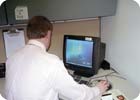One-card Convergence

Brian Ingraham (left) of Wire Tech Inc. discusses intricacies of an access control panel with Duane Terpstra and Eric Patterson of Davenport University.
Safety first, of course. But when security executives face community-like organizations where cardholders must perform a variety of activities, the business strategy can be convergence on a one-card solution.
That’s the case at Davenport University, which serves more than 13,000 students through its main campus in Grand Rapids, Mich., and more than 20 other locations in Michigan and Indiana plus online. In keeping with the university’s reputation as a leader in technology education, Davenport president Randolph Flechsig ensured that the latest technology was also used to provide a safe campus environment. This decision resulted in the implementation of a card access system.

Davenport University has shifted to electronic access with a central database. The bottom line: a one-card access control system that will enlarge across all the university’s facilities and needs.
Access control approach
Chosen to control more than 90 interior doors was Exton, Pa.-based Compass Technologies’ multi-user, multi-platform-based 5E access control and security management system implemented through the NuVision Networks OneCard. Since the doors and locks were already in place, the system would employ Schlage Lock’s Value Integration Platform (VIP), to accomplish reading capabilities and monitoring.Wire Tech Inc., a systems integrator specializing in diversified wiring and security access management systems, would integrate and install the system. The company had previously worked with the university on other projects.
Brian Ingraham, president of Wire Tech, explained that VIP works with existing infrastructure, employing a pair of two-conductor wires from hinge to panel interface board (PIB). This installation replaces what is typically a 14-conductor cable and saves many hours of labor at each door and provides a cleaner and less expensive installation.
He noted that the system has never before been applied to so many doors in one facility. It was a first and custom implementation procedure.
The main campus opened its access-controlled doors in the fall of 2005 and the final two doors went online in mid-February 2006. Within the next 18 months, the school expects to employ the card system for all registered student photo IDs, so that access, credit, food services, library, gym, copy printing, bookstore and other campus requirements are all available through the single card. Eventually, there will be temporary cards for transient visitors.
The university also plans to use the card access system with the 34 additional doors of the residence hall currently under construction. The main campus, the W. A. Letting Campus, is the university’s only residential campus. In addition to card access, it has security cameras and fulltime security officers.

Brian Ingraham of integrator Wire Tech Inc. inspects access control panel at the university site.
The central DB
The downtown location, on Fulton Street in Grand Rapids, occupies most of a city block. It is the location of the school’s central database, so the security director can review all operations from his desk. It is anticipated that the downtown Grand Rapids, Warren and Dearborn locations will be tied into the new access control system in the future. The main campus is controlled by a remote workstation from the central database and other applications will be added in the future.The next step will be the implementation of a new software system to support financial and human resources functions, while seamlessly connecting with the Compass and NuVision systems.

Campus safety staff inputs student information into the access control system.
System details
In the VIP system, each reader on each door has its own identity and a point of magnetic contact indicating whether the door is open or closed. This information goes through a data path (via the two-conductor wire) from the doorway back to the PIB that connects directly to the access control system. Four doors may be connected to each PIB.Information technology, security, food service and maintenance staff, as well as faculty and administrative staff, may be granted different levels of access as appropriate.
Classrooms can be locked down or unlocked, timeframes are alterable and special arrangements can be made by instructors through the security department. Using the software, access to classrooms can be programmed as needed, even during off hours.
Ultimately, all of the workstation computers used for student registration will communicate with each other and work together. When a student registers, the information and ID photo will be immediately downloaded from the NuVision system to the Compass card access system software. Capabilities of the card system will be integrated and implemented at other campuses.
Eventually, the university expects to take its access control arrangements campus-wide, from Northern Indiana to the top of Michigan’s lower peninsula, all supervised from the downtown location. When the arrangement is implemented throughout the school, keys will no longer be necessary, regulation of who comes and goes will be improved, and access will be limited to designated user levels according to the needs of each specific area. V
Looking for a reprint of this article?
From high-res PDFs to custom plaques, order your copy today!




